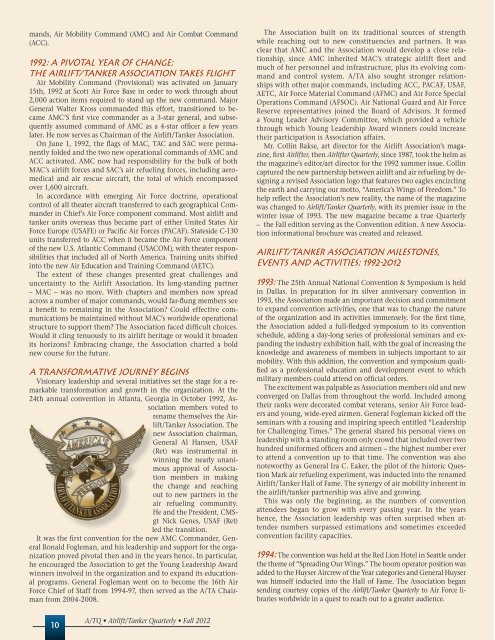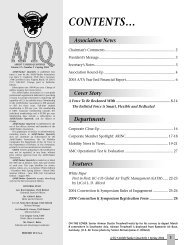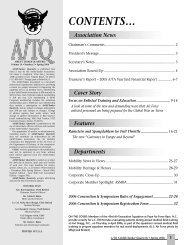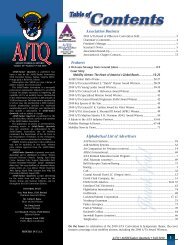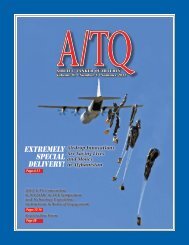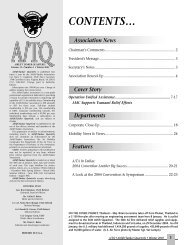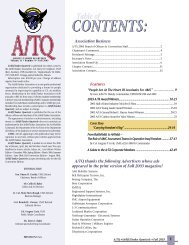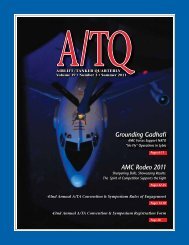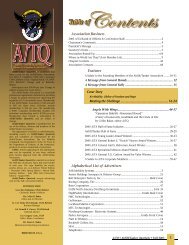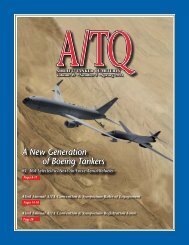A/TQ covers - Airlift/Tanker Association
A/TQ covers - Airlift/Tanker Association
A/TQ covers - Airlift/Tanker Association
Create successful ePaper yourself
Turn your PDF publications into a flip-book with our unique Google optimized e-Paper software.
mands, Air Mobility Command (AMC) and Air Combat Command<br />
(ACC).<br />
1992: A Pivotal Year of Change;<br />
the <strong>Airlift</strong>/<strong>Tanker</strong> <strong>Association</strong> Takes Flight<br />
Air Mobility Command (Provisional) was activated on January<br />
15th, 1992 at Scott Air Force Base in order to work through about<br />
2,000 action items required to stand up the new command. Major<br />
General Walter Kross commanded this effort, transitioned to became<br />
AMC’S first vice commander as a 3-star general, and subsequently<br />
assumed command of AMC as a 4-star officer a few years<br />
later. He now serves as Chairman of the <strong>Airlift</strong>/<strong>Tanker</strong> <strong>Association</strong>.<br />
On June 1, 1992, the flags of MAC, TAC and SAC were permanently<br />
folded and the two new operational commands of AMC and<br />
ACC activated. AMC now had responsibility for the bulk of both<br />
MAC’s airlift forces and SAC’s air refueling forces, including aeromedical<br />
and air rescue aircraft, the total of which encompassed<br />
over 1,600 aircraft.<br />
In accordance with emerging Air Force doctrine, operational<br />
control of all theater aircraft transferred to each geographical Commander<br />
in Chief’s Air Force component command. Most airlift and<br />
tanker units overseas thus became part of either United States Air<br />
Force Europe (USAFE) or Pacific Air Forces (PACAF). Stateside C-130<br />
units transferred to ACC when it became the Air Force component<br />
of the new U.S. Atlantic Command (USACOM), with theater responsibilities<br />
that included all of North America. Training units shifted<br />
into the new Air Education and Training Command (AETC).<br />
The extent of these changes presented great challenges and<br />
uncertainty to the <strong>Airlift</strong> <strong>Association</strong>. Its long-standing partner<br />
– MAC – was no more. With chapters and members now spread<br />
across a number of major commands, would far-flung members see<br />
a benefit to remaining in the <strong>Association</strong>? Could effective communications<br />
be maintained without MAC’s worldwide operational<br />
structure to support them? The <strong>Association</strong> faced difficult choices.<br />
Would it cling tenuously to its airlift heritage or would it broaden<br />
its horizons? Embracing change, the <strong>Association</strong> charted a bold<br />
new course for the future.<br />
A Transformative Journey Begins<br />
Visionary leadership and several initiatives set the stage for a remarkable<br />
transformation and growth in the organization. At the<br />
24th annual convention in Atlanta, Georgia in October 1992, <strong>Association</strong><br />
members voted to<br />
rename themselves the <strong>Airlift</strong>/<strong>Tanker</strong><br />
<strong>Association</strong>. The<br />
new <strong>Association</strong> chairman,<br />
General Al Hansen, USAF<br />
(Ret) was instrumental in<br />
winning the nearly unanimous<br />
approval of <strong>Association</strong><br />
members in making<br />
the change and reaching<br />
out to new partners in the<br />
air refueling community.<br />
He and the President, CMSgt<br />
Nick Genes, USAF (Ret)<br />
led the transition.<br />
It was the first convention for the new AMC Commander, General<br />
Ronald Fogleman, and his leadership and support for the organization<br />
proved pivotal then and in the years hence. In particular,<br />
he encouraged the <strong>Association</strong> to get the Young Leadership Award<br />
winners involved in the organization and to expand its educational<br />
programs. General Fogleman went on to become the 16th Air<br />
Force Chief of Staff from 1994-97, then served as the A/TA Chairman<br />
from 2004-2008.<br />
The <strong>Association</strong> built on its traditional sources of strength<br />
while reaching out to new constituencies and partners. It was<br />
clear that AMC and the <strong>Association</strong> would develop a close relationship,<br />
since AMC inherited MAC’s strategic airlift fleet and<br />
much of her personnel and infrastructure, plus its evolving command<br />
and control system. A/TA also sought stronger relationships<br />
with other major commands, including ACC, PACAF, USAF,<br />
AETC, Air Force Material Command (AFMC) and Air Force Special<br />
Operations Command (AFSOC). Air National Guard and Air Force<br />
Reserve representatives joined the Board of Advisors. It formed<br />
a Young Leader Advisory Committee, which provided a vehicle<br />
through which Young Leadership Award winners could increase<br />
their participation is <strong>Association</strong> affairs.<br />
Mr. Collin Bakse, art director for the <strong>Airlift</strong> <strong>Association</strong>’s magazine,<br />
first <strong>Airlift</strong>er, then <strong>Airlift</strong>er Quarterly, since 1987, took the helm as<br />
the magazine’s editor/art director for the 1992 summer issue. Collin<br />
captured the new partnership between airlift and air refueling by designing<br />
a revised <strong>Association</strong> logo that features two eagles encircling<br />
the earth and carrying our motto, “America’s Wings of Freedom.” To<br />
help reflect the <strong>Association</strong>’s new reality, the name of the magazine<br />
was changed to <strong>Airlift</strong>/<strong>Tanker</strong> Quarterly, with its premier issue in the<br />
winter issue of 1993. The new magazine became a true Quarterly<br />
– the Fall edition serving as the Convention edition. A new <strong>Association</strong><br />
informational brochure was created and released.<br />
<strong>Airlift</strong>/<strong>Tanker</strong> <strong>Association</strong> Milestones,<br />
Events and Activities; 1992-2012<br />
1993: The 25th Annual National Convention & Symposium is held<br />
in Dallas. In preparation for its silver anniversary convention in<br />
1993, the <strong>Association</strong> made an important decision and commitment<br />
to expand convention activities, one that was to change the nature<br />
of the organization and its activities immensely. For the first time,<br />
the <strong>Association</strong> added a full-fledged symposium to its convention<br />
schedule, adding a day-long series of professional seminars and expanding<br />
the industry exhibition hall, with the goal of increasing the<br />
knowledge and awareness of members in subjects important to air<br />
mobility. With this addition, the convention and symposium qualified<br />
as a professional education and development event to which<br />
military members could attend on official orders.<br />
The excitement was palpable as <strong>Association</strong> members old and new<br />
converged on Dallas from throughout the world. Included among<br />
their ranks were decorated combat veterans, senior Air Force leaders<br />
and young, wide-eyed airmen. General Fogleman kicked off the<br />
seminars with a rousing and inspiring speech entitled “Leadership<br />
for Challenging Times.” The general shared his personal views on<br />
leadership with a standing room only crowd that included over two<br />
hundred uniformed officers and airmen – the highest number ever<br />
to attend a convention up to that time. The convention was also<br />
noteworthy as General Ira C. Eaker, the pilot of the historic Question<br />
Mark air refueling experiment, was inducted into the renamed<br />
<strong>Airlift</strong>/<strong>Tanker</strong> Hall of Fame. The synergy of air mobility inherent in<br />
the airlift/tanker partnership was alive and growing.<br />
This was only the beginning, as the numbers of convention<br />
attendees began to grow with every passing year. In the years<br />
hence, the <strong>Association</strong> leadership was often surprised when attendee<br />
numbers surpassed estimations and sometimes exceeded<br />
convention facility capacities.<br />
1994: The convention was held at the Red Lion Hotel in Seattle under<br />
the theme of “Spreading Our Wings.” The boom operator position was<br />
added to the Huyser Aircrew of the Year categories and General Huyser<br />
was himself inducted into the Hall of Fame. The <strong>Association</strong> began<br />
sending courtesy copies of the <strong>Airlift</strong>/<strong>Tanker</strong> Quarterly to Air Force libraries<br />
worldwide in a quest to reach out to a greater audience.<br />
10<br />
A/<strong>TQ</strong> • <strong>Airlift</strong>/<strong>Tanker</strong> Quarterly • Fall 2012


